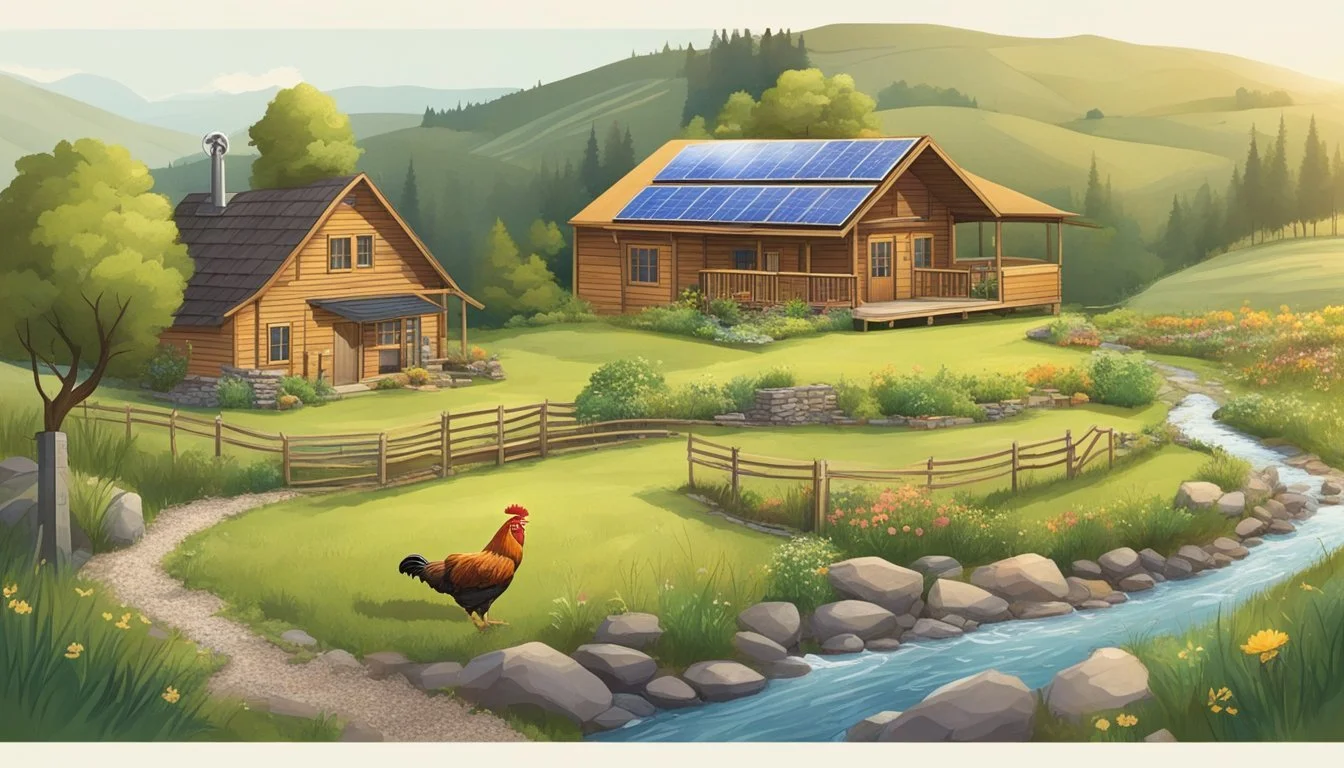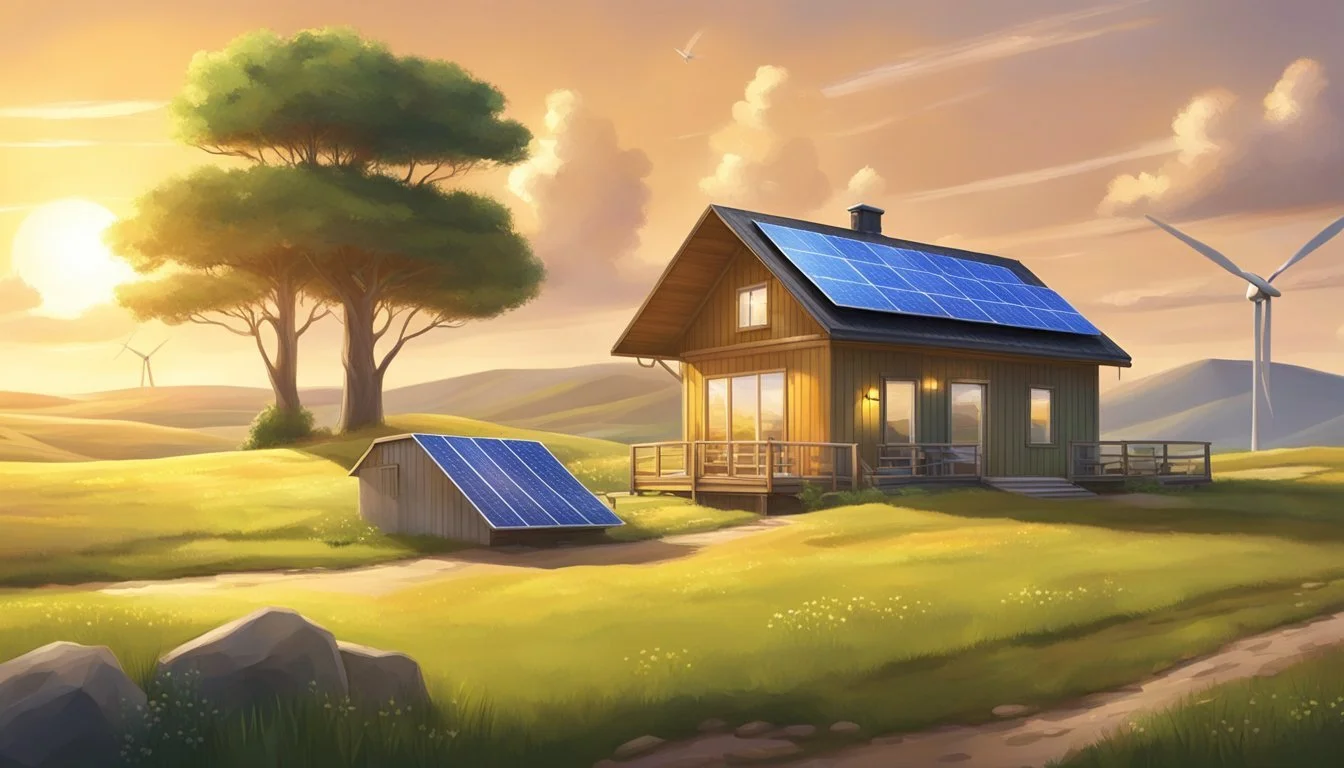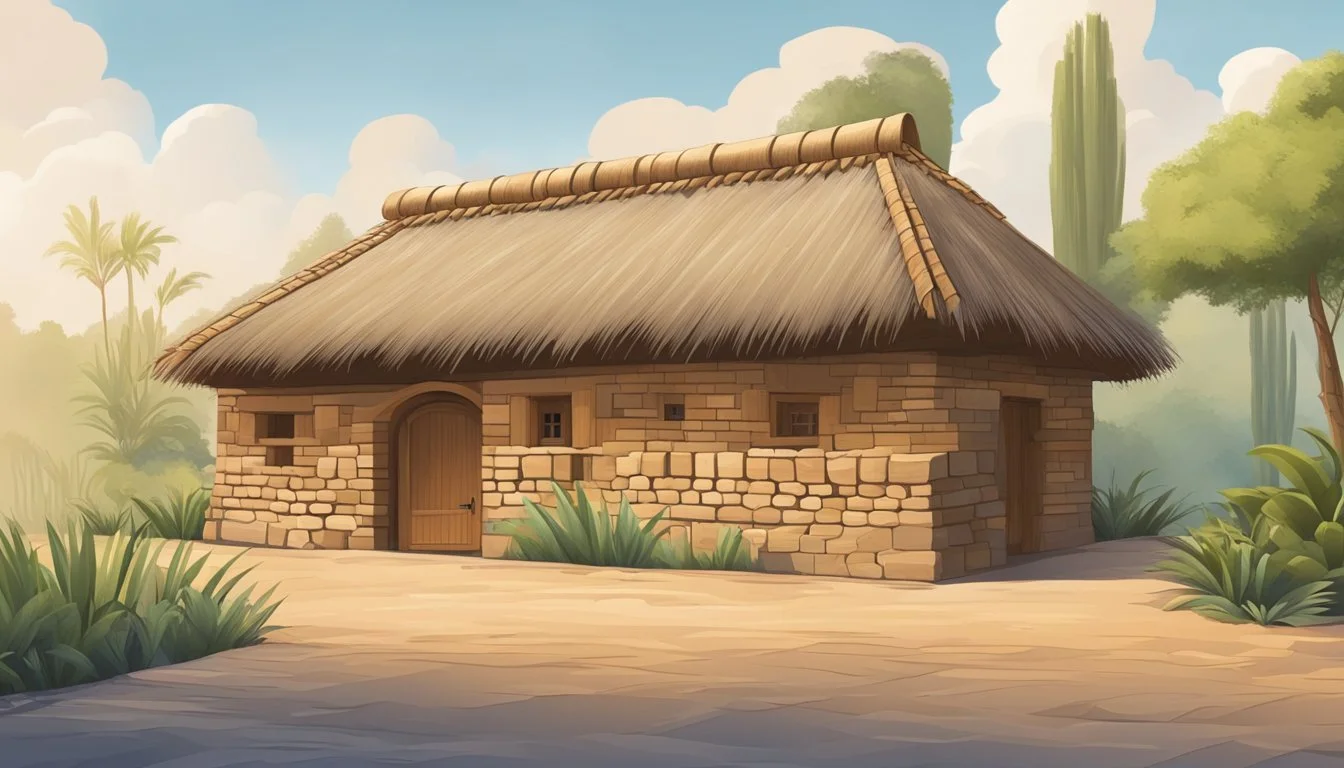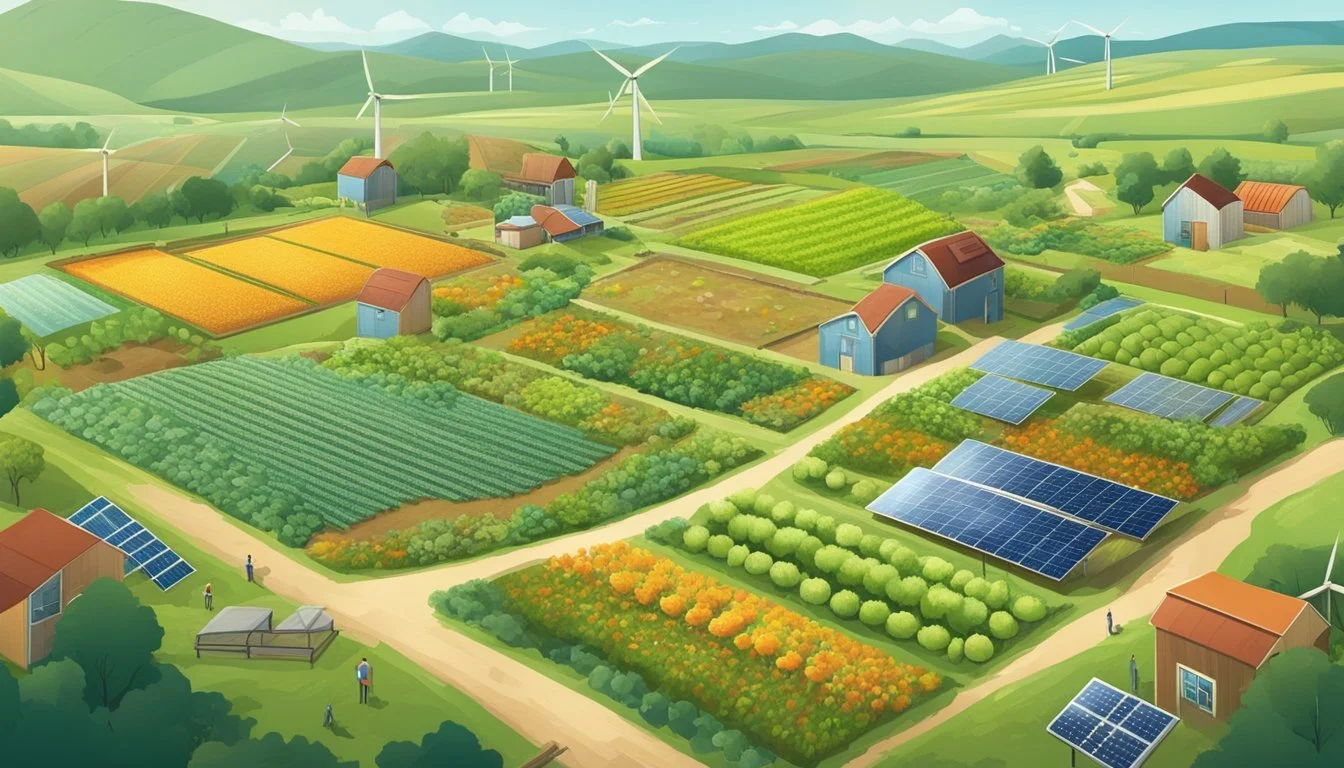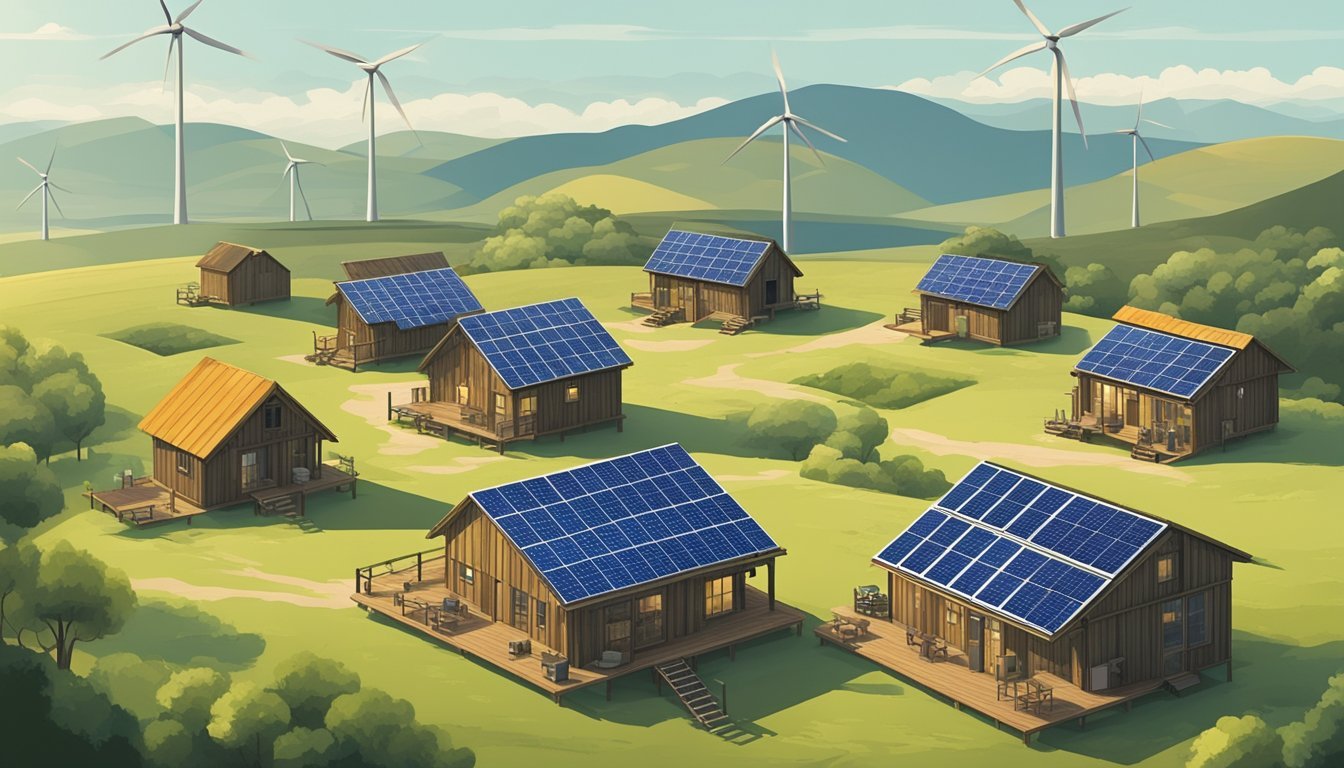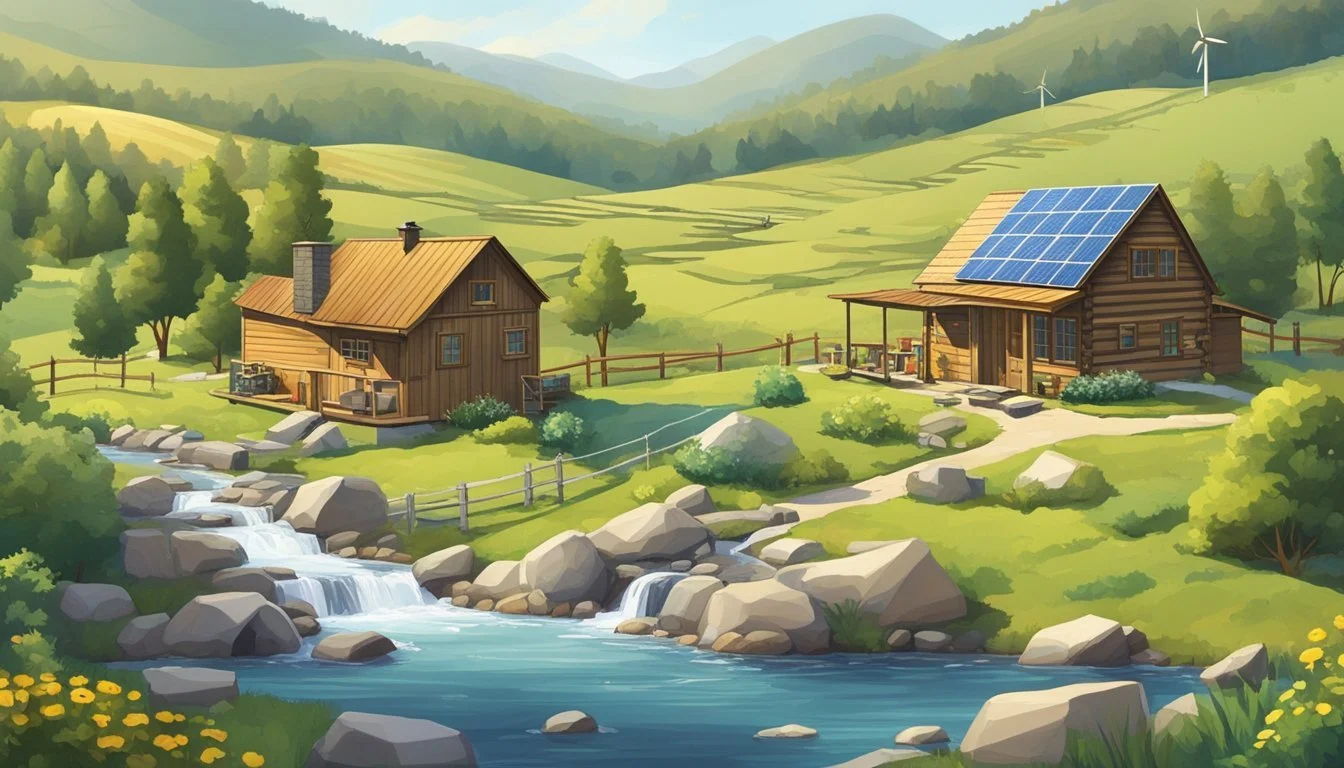Southern Plains Off Grid Living
A Comprehensive Guide to Sustainable Independence
Embracing off-grid living in the Southern Plains offers a unique blend of challenges and rewards, attracting those who seek a sustainable and self-sufficient lifestyle. This region, characterized by its vast open landscapes and abundant natural resources, provides an ideal setting for those looking to disconnect from conventional utilities and live closer to nature.
Southern Plains residents find an abundance of renewable energy sources such as solar and wind power, crucial for maintaining an off-grid lifestyle. From the wind-swept plains of Perkins County in South Dakota to the fertile soils of Aurora County, opportunities abound for harnessing natural energy and cultivating self-reliance. The low population density and affordable property rates further make these areas attractive for off-grid enthusiasts.
Communities in these regions thrive on a shared commitment to sustainability and self-sufficiency. They often embrace innovative agricultural practices, water conservation techniques, and communal support systems that enhance their off-grid living experience. These efforts not only foster a sense of community but also significantly reduce their ecological footprint, showcasing a viable path for future generations.
Understanding Off-Grid Living
Off-grid living means operating independently from public utilities. Individuals generate their own power, manage their water supply, and handle waste independently. This lifestyle promotes self-reliance and decreases dependence on fossil fuels.
A critical component of off-grid living is the use of alternative energy sources. Solar panels are commonly employed to harness sunlight, while wind turbines or hydroelectric systems can supplement power needs. These methods reduce reliance on conventional electricity grids.
Water management is also essential. Collecting rainwater, drilling wells, and using natural water sources provide essential resources. Filters and purification systems ensure water quality. Compost toilets and natural waste management strategies are utilized to maintain environmental sustainability.
Living off-grid often necessitates a significant initial investment. Setting up solar panels, buying land in remote areas, and configuring water systems can be costly. However, these upfront costs can lead to financial freedom in the long run by minimizing monthly utility bills.
Sustainable living practices are integral to this lifestyle. They include growing food, preserving energy, and minimizing waste. This approach not only supports environmental benefits but also reduces the individual’s carbon footprint.
Challenges of off-grid living include isolation and maintenance. Living away from urban centers can mean fewer social interactions and limited access to services. Regular upkeep of power and water systems is essential to ensure long-term sustainability.
In summary, off-grid living is a lifestyle choice that emphasizes independence, sustainability, and self-sufficiency. Through careful planning and commitment, individuals can create a fulfilling and environmentally responsible way of living.
Choosing the Right Location
Selecting the perfect site for off-grid living in the Southern Plains requires attention to climate, natural resources, zoning laws, and population density. Proper planning ensures a sustainable and fulfilling off-grid lifestyle.
Climate Considerations
The climate of the Southern Plains, known for its hot summers and mild winters, significantly influences living conditions. Areas like Oklahoma and Texas exhibit wide temperature variations. It's crucial to prepare for both extreme heat and occasional cold snaps.
Adequate protection from harsh weather, such as robust shelter and sufficient ventilation, is essential. Wind conditions, especially in states like Kansas, should be assessed. A location with moderate rainfall and suitable for rainwater harvesting enhances water security.
Special attention should be given to potential flooding areas and selecting elevated land minimizes this risk. Adaptation to local weather patterns ensures better comfort and resource management.
Assessing Natural Resources
Access to natural resources plays a pivotal role in maintaining an off-grid lifestyle. Prioritize locations with abundant water sources, such as creeks, rivers, or reliable groundwater. Natural beauty, such as nearby forests or prairies, provides opportunities for sourcing wood and other materials.
Soil quality is paramount for growing food. Rich, fertile soil supports diverse gardening options, from vegetables to fruit trees. Additionally, areas with active wildlife can provide hunting opportunities.
Choosing land with renewable energy potential, such as well-placed solar and wind resources, is also vital. Maximizing these natural resources ensures long-term sustainability and reduces dependence on external supplies.
Zoning Laws and Building Codes
Understanding and adhering to zoning laws and building codes is crucial. These regulations vary by county and state, so thorough research is necessary. Some rural areas may offer more lenient codes, facilitating more flexible building options.
Ensure that the off-grid structures meet safety standards. Some regions might have specific codes for renewable energy installations or water storage systems. Obtain clearances and permits to avoid legal issues and fines.
Zoning laws often dictate land use, impacting agricultural activities or livestock keeping. Familiarity with these regulations ensures that the chosen location supports the intended off-grid lifestyle without legal constraints.
Population Density and Property Taxes
Population density affects privacy and resource availability. Rural areas in the Southern Plains offer the solitude desirable for off-grid living. Lower population density generally means less competition for resources like water and firewood.
Property taxes are another critical factor. States like Texas, Oklahoma, and Kansas have varied tax rates. Rural properties often have lower taxes, easing financial burdens. Investigate local tax incentives for sustainable practices or agricultural use.
Consider proximity to nearby towns for essential supplies and emergency services. Balancing remoteness with accessibility ensures a comfortable off-grid setup. Properly evaluating these aspects aids in selecting an ideal, sustainable homestead.
Setting Up a Sustainable Homestead
Creating a sustainable homestead requires thoughtful planning. Key areas include designing for efficiency, utilizing renewable energy sources, managing water collection, and developing food production and preservation systems.
Designing for Efficiency
Efficient design maximizes space and resources while minimizing waste. A well-thought-out layout allows easy access to essential resources like water and food. Buildings should be oriented to take advantage of natural light and wind patterns for temperature regulation.
Permaculture principles can guide the placement of gardens, with high-yield plants located near living areas and less frequently used crops further away. Energy-efficient materials and designs, such as passive solar heating and insulated walls, reduce dependency on external energy sources.
Renewable Energy Sources
Implementing renewable energy sources is critical for an off-grid homestead. Solar power systems are ideal for the Southern Plains due to abundant sunlight. These systems can provide substantial energy for daily needs if installed correctly.
Wind power can be a supplementary source, particularly in areas with consistent wind patterns. Small wind turbines can be used to generate additional electricity. Combining both solar and wind power increases reliability and reduces outages, providing a steady energy supply.
Water Collection and Management
Effective water management ensures a consistent supply for both household use and agriculture. Rainwater harvesting systems are highly effective; they require only a collection area, storage tanks, and filtration systems to provide clean water.
Greywater systems can be implemented to recycle household water for irrigation purposes. Additionally, ponds or cisterns can be constructed to store rainwater or runoff, ensuring a water supply during dry periods. Efficient water use practices, such as drip irrigation, can minimize waste and promote sustainability.
Food Production and Preservation
A mix of traditional gardening techniques and permaculture principles can optimize food production. Greenhouses extend the growing season, providing fresh produce year-round. Crops should be chosen based on the local climate and soil conditions to ensure maximum yield.
Livestock can provide meat, eggs, and dairy products. Choosing breeds that are well-suited to the local environment will increase success. Food preservation methods, such as canning, drying, and fermenting, ensure that surplus produce is stored for off-season use, maintaining food supply stability.
By addressing these key areas with careful planning and resource optimization, a sustainable homestead in the Southern Plains can thrive independently.
Energy Solutions for Off-Grid Life
Living off the grid in the Southern Plains requires reliable and sustainable energy solutions. Key methods include harnessing solar power, utilizing wind energy, and implementing battery storage systems for backup.
Solar Energy Systems
Solar energy systems offer a practical solution for off-grid energy needs. With an abundance of sunlight in the Southern Plains, solar panels can generate significant amounts of electricity. These systems consist of photovoltaic (PV) panels, inverters, and charge controllers to convert sunlight into usable power.
The installation of solar panels can be done on rooftops or as ground-mounted arrays. The efficiency of these systems primarily depends on proper orientation and tilt to maximize sun exposure. Solar energy is also clean and renewable, reducing the environmental footprint of off-grid living. Additionally, integrating solar with other energy sources can enhance reliability.
Wind Energy Options
Wind energy is another viable option for off-grid living. In the Southern Plains, the availability of consistent and strong winds makes wind turbines an effective energy solution. Small to medium-sized wind turbines can be installed on properties to capture wind power and convert it into electricity.
Wind turbines should be placed in open areas, free from obstructions that could block wind flow. Key components include the rotor blades, a tower, and a generator. The height of the tower is crucial for accessing stronger and more consistent winds. Combining wind energy with solar systems can provide a balanced energy supply, particularly during cloudy or windless days.
Battery Storage and Backup
Battery storage systems are essential for managing off-grid energy supply. These systems store excess energy generated from solar panels and wind turbines, ensuring a steady power supply even when production is low. Common battery types include lead-acid, lithium-ion, and nickel-cadmium.
Lithium-ion batteries are often preferred for their efficiency and longer lifespan. Properly sized battery banks can provide several days of backup power. Additionally, integrating a backup generator can enhance reliability, especially during prolonged periods of low solar or wind activity. Effective energy management and monitoring systems are also crucial to optimize usage and prolong battery life.
Building and Construction Methods
To successfully build an off-grid home in the Southern Plains, it's essential to plan with sustainability in mind. Consider factors like building codes, passive solar design, and using natural materials.
Understanding Off-Grid Architecture
Off-grid architecture focuses on maximizing energy efficiency and self-sufficiency. Passive solar design is critical here. This involves designing the home to naturally regulate temperature. Large south-facing windows capture sunlight in the winter, while overhangs provide shade in the summer.
Meeting local building codes is vital. Researching regulations related to renewable energy installations, water harvesting, and waste disposal systems can save time and prevent fines.
Natural Building Materials
Natural materials like cob, straw bales, and adobe bricks are popular for off-grid construction due to their low environmental impact and excellent insulation properties. Cob, a mix of clay, straw, and sand, is particularly favored for its durability and thermal mass.
Using natural materials typically means the home has better breathability, reducing the need for artificial ventilation systems. Additionally, these materials are often locally sourced, further reducing the environmental footprint.
DIY Construction Challenges
Building an off-grid home oneself can be rewarding but comes with challenges. Knowledge of carpentry, plumbing, and electrical systems tailored to off-grid technologies is essential.
DIY builders must be prepared to handle everything from installing solar panels to setting up rainwater harvesting systems. Ensuring compliance with building codes, while managing time and cost constraints, is crucial for a successful project.
Off-Grid Water Systems
A key component of off-grid living in the Southern Plains is ensuring a reliable and sustainable water supply. Off-grid water systems can incorporate various methods to provide clean water without relying on municipal services.
Manual Well Pumps: A classic option for off-grid water collection is the manual well pump. It draws water from deep underground, using old but reliable technology. These pumps don't require electricity, making them perfect for a truly self-sufficient lifestyle.
Rainwater Harvesting: Rainwater harvesting systems collect and store rainwater for later use. These systems usually consist of catchment areas like roofs, gutters for channeling the water, and tanks for storage. This method is both eco-friendly and practical in areas with consistent rainfall.
Gravity-Fed Systems: Gravity-fed water systems use the natural force of gravity to move water from a higher elevation to where it's needed. Typically, water is stored in an elevated tank and flows down to taps and appliances, ensuring a continuous supply without the need for pumps.
UV Water Purification: To ensure the water is safe to drink, many off-grid setups include UV water purification systems. These systems use ultraviolet light to eliminate bacteria, viruses, and protozoa, providing a reliable method of disinfection.
Sustainability: Sustainable practices are vital in maintaining an off-grid water system. Using natural sources like wells and rain ensures that water usage doesn't deplete the environment. Moreover, these methods often require minimal energy, aligning with the principles of sustainable living.
By combining these techniques, off-grid residents can enjoy a consistent and eco-friendly water supply. This combination of methods not only ensures reliability but also enhances self-sufficiency and sustainability.
Sustainable Food Systems
Sustainable food systems form a critical part of off-grid living in the Southern Plains. Individuals and communities aim at producing their food locally through agriculture, livestock, and permaculture techniques.
Gardening: Growing cold-hardy vegetables like cabbage, kale, carrots, and beets is recommended, as they adapt well to the local climate. Raised beds and greenhouses can extend the growing season.
Livestock: Raising chickens, goats, and sheep provides a sustainable source of meat, milk, and eggs. Proper care and rotation are essential to maintain soil health and reduce overgrazing.
Permaculture: This system integrates plants, animals, and the environment into a cohesive and self-sustaining unit. Techniques like companion planting and mulching aid in enriching the soil and conserving water.
Water Management: Collecting rainwater and implementing efficient irrigation techniques are beneficial practices. Drip irrigation systems help in delivering water directly to the plant roots, reducing wastage.
Food Storage: Preserving food through canning, drying, and fermenting ensures that surplus produce is available throughout the year. Root cellars provide a traditional method for storing vegetables in a cool and humid environment.
Community Involvement: Collaborative efforts in resource sharing and exchanging surplus produce strengthen community bonds and resilience. This collective approach benefits everyone and promotes sustainable living.
Adopting these methods ensures that off-grid communities can meet their food needs sustainably, reducing dependence on external sources and achieving greater self-sufficiency.
Legal Aspects and Living Legally Off the Grid
Living off the grid in the Southern Plains involves navigating various laws and regulations related to land ownership, property tax, and building codes, which are essential for ensuring a legally compliant lifestyle.
Land Ownership and Property Laws
Acquiring land for off-grid living requires understanding specific property laws and zoning regulations in the Southern Plains. These laws differ from one state to another, making it crucial to research local requirements thoroughly.
Property taxes are a significant consideration, as off-grid properties are still subject to taxation based on land value and other factors. Zoning laws may dictate the permissible use of land, including residential, agricultural, or mixed-use designations.
Some regions may offer more lenient zoning regulations, allowing for greater flexibility in establishing an off-grid homestead.
Building Regulations and Compliance
Building codes play a vital role in legal off-grid living, ensuring structures meet safety and health standards. These codes govern everything from the installation of utilities to structural integrity. In the Southern Plains, building regulations can vary significantly between urban and rural areas.
Permits are often required for constructing new buildings or modifying existing ones, ensuring that they comply with local codes. While some areas might have exemptions for alternative dwellings like tiny houses or cabins, most require adherence to standard building codes.
Non-compliance can lead to fines or legal issues, making it essential to stay informed about local regulations.
Community and Lifestyle
Off-grid communities in the Southern Plains foster a distinctive lifestyle centered on self-sufficiency and sustainability. Residents prioritize living harmoniously with nature.
People engage in varied activities such as organic farming, harvesting rainwater, and using renewable energy sources like solar and wind. These practices reduce their carbon footprint and reliance on urban infrastructure.
Community spirit is a cornerstone. Many off-grid dwellers form tight-knit networks, collaborating on projects, sharing resources, and providing mutual support. This collective effort strengthens their resilience in facing challenges like extreme weather and resource scarcity.
Preparedness is crucial. Off-grid living demands skills in areas like carpentry, plumbing, and electrical work. These skills are essential for maintaining homes and systems without external help.
Despite the rewards, this lifestyle presents challenges. Ensuring a steady water supply, managing waste effectively, and producing enough food year-round are ongoing concerns. Off-grid communities constantly innovate to overcome these difficulties, emphasizing ingenuity and adaptability.
In these communities, there's a blend of traditional knowledge and modern technology. People often utilize solar panels and energy-efficient appliances while also practicing age-old techniques like composting and earth berm construction.
The off-grid lifestyle in the Southern Plains nurtures a sense of independence and connection. It draws individuals committed to reducing their environmental impact and leading fulfilling lives outside conventional norms. The blend of cooperation, resourcefulness, and respect for nature makes these communities unique.
Climate Impact and Environmental Responsibility
Living off-grid in the Southern Plains necessitates a deep appreciation of the climate's role and the need for sustainable practices to reduce one's environmental impact. This includes minimizing carbon emissions and maintaining harmony with local wildlife and ecosystems.
Reducing Carbon Footprint
For off-grid living in the Southern Plains, reducing the carbon footprint is crucial. Renewable energy sources like solar and wind are highly effective due to the region's ample sunlight and wind patterns. Solar panels can be installed on rooftops or nearby land, requiring careful placement to maximize exposure.
Wind turbines are another option, especially in areas with consistent wind speeds. When selecting wind turbines, consider factors such as size, noise, and maintenance needs. Utilizing these renewable sources minimizes dependence on fossil fuels and reduces greenhouse gas emissions.
Additionally, the use of energy-efficient appliances and LED lighting can further lower energy consumption. Incorporating rainwater harvesting systems and composting toilets also plays a significant role in reducing the household's overall environmental impact.
Wildlife and Ecosystem Interactions
Off-grid living in the Southern Plains involves a responsibility to protect local wildlife and ecosystems. The region is home to diverse species, some of which are sensitive to habitat disturbances. Implementing eco-friendly practices ensures minimal disruption to these natural habitats.
One important practice is maintaining native vegetation around the property, which supports local wildlife and helps preserve biodiversity. Avoiding the use of harmful pesticides and chemicals is also essential, as these can harm wildlife and contaminate water sources.
Creating wildlife corridors can facilitate the safe passage of animals through the property, reducing the risk of accidents and promoting ecological balance. Additionally, sustainable building materials and practices, such as using reclaimed wood or recycled metals, can minimize habitat destruction.
By integrating these strategies, off-grid residents can minimize their impact on the environment and contribute positively to the region's ecological health.
Preparedness and Overcoming Challenges
Preparedness is a cornerstone of off-grid living in the Southern Plains. This involves having essential supplies, equipment, and training in place. Being proactive can significantly aid in responding effectively to emergencies.
One of the primary challenges is finding the right location. The chosen spot needs to provide access to natural resources like sunlight and water. Proximity to supplies such as food and building materials is also vital.
Equipment and Supplies should include water storage, renewable energy sources like solar panels, and non-perishable food. A well-stocked first aid kit and basic medical training are critical for ensuring safety.
Dealing with isolation can be another hurdle. Establishing a strong community network is beneficial for both social interaction and mutual support in emergencies. Regular communication with nearby off-grid enthusiasts can provide practical advice and assistance.
Self-sufficiency is key. This involves growing your own food, collecting and purifying water, and generating power independently. Adequate training in these areas can make the transition smoother.
Weather conditions in the Southern Plains can be severe. Preparing for extreme weather events, such as tornadoes and droughts, requires having sturdy shelters and reliable communication tools.
Here's a brief summary of key items to consider:
Area Key Considerations Location Access to resources, supplies Equipment Water storage, solar panels Community Network Mutual support, social contact Self-Sufficiency Food, water, power Weather Preparedness Sturdy shelters, tools
By planning thoroughly and addressing these challenges, individuals can thrive off-grid in the Southern Plains.
Technology and Innovations in Off-Grid Living
Technology has dramatically advanced off-grid living by providing sustainable solutions.
Renewable energy is at the forefront. Solar power utilizes photovoltaic panels to convert sunlight into electricity. Residents install these panels on rooftops or open fields to harness maximum sunlight. In South Dakota, solar energy is particularly valuable during long summer days.
Wind power is another critical technology. Wind turbines generate electricity by capturing wind energy. Perkins County in South Dakota showcases this with numerous turbines dotting the landscape. These turbines convert wind into a reliable energy source, supplementing solar power during cloudy or nighttime conditions.
Battery storage systems are essential to store excess energy generated by solar and wind. Advanced lithium-ion batteries allow off-grid homes to have a consistent power supply, even during periods of low generation. This ensures uninterrupted access to electricity.
Water filtration technology is vital. Portable and home-based filtration systems make it possible to purify water from natural sources. These systems use techniques like reverse osmosis and UV treatment to provide safe drinking water.
In communication technology, satellite internet ensures connectivity even in remote areas. This helps residents stay informed and maintain contact with the wider world.
Agricultural technology also plays a role. Hydroponics and aquaponics systems enable efficient farming without relying solely on natural soil and weather conditions. These systems are highly productive and conserve water.
Smart home systems manage energy consumption efficiently. Residents use smart thermostats, lighting, and appliances to reduce energy waste, optimizing the power generated by renewable sources.
These innovations enable self-sufficient, sustainable off-grid living in the Southern Plains.
Health, Safety, and Security Consideration
Health Concerns
Health is a primary consideration for those living off the grid on the Southern Plains. Residents need reliable access to clean water. Using filters or purification systems can prevent waterborne illnesses. Additionally, establishing a basic first aid kit and knowing how to use it is critical, given the distance from medical facilities.
Safety Measures
Electrical safety is paramount. Many off-grid homes generate electricity via solar panels or wind turbines. Proper installation and regular maintenance of these systems prevent accidents. Residents should avoid DIY installations unless they have proper knowledge and training.
Fire safety is also a concern. Install smoke detectors and maintain clear zones around heat sources. Having an evacuation plan can save lives in the event of a wildfire or home fire.
Security Measures
Off-grid living requires heightened situational awareness. Constant vigilance and understanding of the surroundings reduce vulnerability. Install security systems, such as cameras and motion sensor lights, to deter potential intruders.
Self-reliance is another key security measure. Building skills in self-defense and emergency response can help residents handle incidents effectively. Keeping communication devices like satellite phones ensures contact with emergency services when needed.
Financial Considerations and Costs
Living off-grid in the Southern Plains comes with various financial considerations and costs. It's crucial to plan carefully to ensure a sustainable lifestyle.
Initial Investment
Land Purchase: Prices can vary widely, but a starting point might be around $200,000. Additional fees such as surveys ($5,000), title insurance ($2,000), and property taxes ($3,000 annually) should be budgeted.
Housing Options: Costs for housing vary:
Used RVs and Shipping Containers: $2,000 to $5,000.
A-frame Homes: As low as $3,500.
DIY Log Cabin Kits: Approximately $25,000 to $50,000.
Energy Systems
Solar Panels: Range from $2.50 to $3.50 per watt.
Wind Turbines: Range from $1,500 to $3,000 per kilowatt.
Total energy system costs can range between $5,000 and $20,000 or more, depending on system size and components.
Monthly Costs
Typical monthly expenses can range widely:
Low-End: $35.42
High-End: $2,264
These expenses include utilities, maintenance, and miscellaneous costs.
Self-Sufficiency Measures
Investing in self-sufficiency can lead to long-term cost savings:
Gardens and Livestock: Costs vary based on the scale but offer significant savings on food.
Water Systems: Wells and septic systems require upfront costs but reduce reliance on external utilities.
Cost Savings
The shift to off-grid living promotes sustainability and self-reliance, leading to reduced utility bills. Initial investments may be high, but over time, the decrease in monthly costs and reliance on municipal services can yield substantial savings.
Off-Grid Living by State
Different states offer unique opportunities and challenges for off-grid living. Factors such as climate, legal regulations, and cost of living all influence the suitability of a state for off-grid lifestyles.
Popular Off-Grid States
New Mexico stands out for its dry climate and affordable land prices, making it attractive for solar power installations. California offers diverse climates from coastal to desert, and it has strong renewable energy incentives despite higher living costs. Missouri is appealing due to its low land prices, moderate climate, and flexible zoning laws.
In South Dakota, the low population density and friendly zoning regulations make it easier to establish an off-grid homestead. Virginia balances a moderate climate with a supportive community for renewable energy. New York provides ample water resources and forests, although land can be expensive. Colorado is known for its mountain regions which offer isolation, coupled with a strong culture of sustainability.
State-Specific Guidelines
New Mexico has regulations supporting solar power and rainwater harvesting, but building codes should be reviewed for rural areas. California mandates stricter environmental standards, so permits for energy systems and water management are essential. Missouri has lenient building codes, but researching local county regulations is crucial as they can differ significantly.
South Dakota's building codes are generally lax, but it’s important to check for any localized regulations around water rights. Virginia has several counties with incentives for sustainable living practices, yet zoning laws can vary widely. New York imposes stringent environmental regulations, particularly in forested areas, but has excellent resources for renewable energy installations. Colorado encourages off-grid living with flexible regulations in rural areas, though compliance with water rights and energy permits is necessary for legalization.
Case Studies and Real-Life Examples
Examining real-world examples provides insights into the successes and challenges faced by off-grid living in the Southern Plains, highlighting specific counties and methods used by residents.
Success Stories
Ben Barthell's off-grid tiny house in Minnehaha County demonstrates the feasibility of a battery-based solar-electric system. By carefully determining energy loads, he selected and sized equipment for a small yet robust photovoltaic (PV) system.
On Lasqueti Island, Melinda and Ezra Auerbach's journey showcases successful off-grid living, emphasizing self-sufficiency. Despite initial challenges, they achieved sustainable living through innovative solutions like rainwater collection and solar power integration.
In Lincoln County, a family successfully transitioned to off-grid life. Key strategies included solar panels, rainwater harvesting, and composting toilets. Each family member contributed to managing resources, emphasizing the importance of community effort in maintaining an off-grid lifestyle.
Common Challenges and Solutions
Off-grid residents in Pennington County frequently face maintenance issues with solar power systems. Regular upkeep and having troubleshooting knowledge significantly reduce downtime, ensuring a consistent energy supply.
In Aurora County, reliable water sources pose a common challenge. Many residents turn to rainwater harvesting systems and subterranean wells to secure their water needs. Effective water management strategies are crucial for sustainable living.
Yankton County sees frequent issues with waste management, especially in remote areas. Composting toilets and greywater recycling systems are implemented to manage this problem efficiently. These methods help minimize environmental impact and promote a sustainable off-grid lifestyle.
Individuals in Bon Homme and Union Counties often encounter difficulties with extreme weather conditions. Building sturdy, insulated homes and having backup energy sources, such as wind turbines, help mitigate these challenges, allowing for a stable off-grid life.

